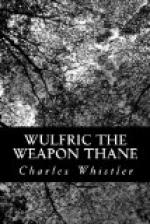PREFACE.
A word may be needed with regard to the sources from which this story of King Eadmund’s armour bearer and weapon thane have been drawn. For the actual presence of such a close attendant on the king at his martyrdom on Nov. 20, 870 A.D. we have the authority of St. Dunstan, who had the story from the lips of the witness himself.
But as to the actual progress of events before the death of the king, the records are vague and imperfect. We are told that, after the defeat at Thetford, the king had intended to seek safety in the church, probably at Framlingham, where the royal household was, but was forced to hide, and from his hiding place was dragged before Ingvar the Danish leader, and so slain.
The two local legends of the “king’s oak” in Hoxne woods, and of the “gold bridge”, may fill in what is required to complete the story.
The former, identifying a certain aged oak as that to which the king was bound, has been in a measure corroborated by the discovery in 1848 of what may well have been a rough arrow point in its fallen trunk; while the fact that, until the erection of the new bridge at Hoxne in 1823, no newly-married couple would cross the “gold bridge” on the way to church, for the reasons given in the story, seems to show that the king’s hiding place may indeed have been beneath it as the legend states. If so, the flight from Thetford must have been most precipitate, and closely followed.
There are two versions of the story of Lodbrok the Dane and Beorn the falconer. That which is given here is from Roger of Wendover. But in both versions the treachery of one Beorn is alleged to have been the cause of the descent of Ingvar and Hubba on East Anglia.
These chiefs and their brother Halfden, and Guthrum, are of course historic. Their campaign in England is hard to trace through the many conflicting chronicles, but the broad outlines given by the almost contemporary Anglo-Saxon Chronicle, supplemented with a few incidents recorded in the Heimskringla of Sturleson as to the first raid on Northumbria by Ingvar, are sufficient for the purposes of a story that deals almost entirely with East Anglia.
The legend of the finding of the head of the martyred king is given in the homily for November 20 of the Anglo-Saxon Sarum Breviary, and is therefore of early date. It may have arisen from some such incident as is given here.
Details of the death of Bishop Humbert are wanting. We only know that he was martyred at about the same time as the king, or perhaps with him, and that his name is remembered in the ancient kalendars on the same day. For describing his end as at his own chapel, still standing at South Elmham, the fate of many a devoted priest of those times might be sufficient warrant.




